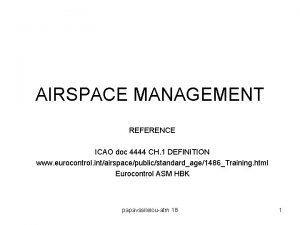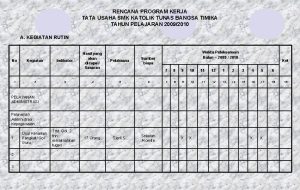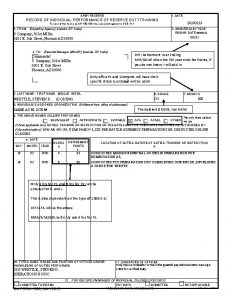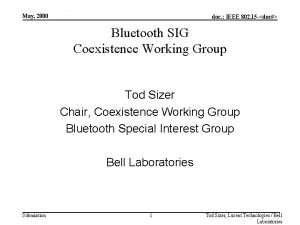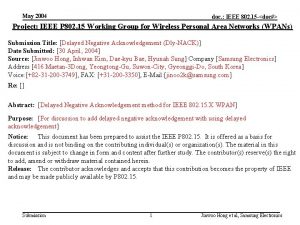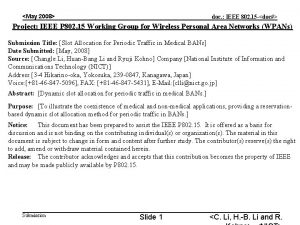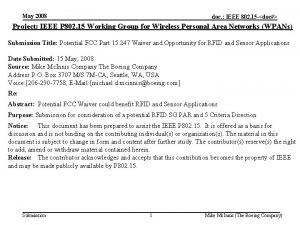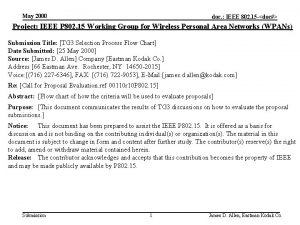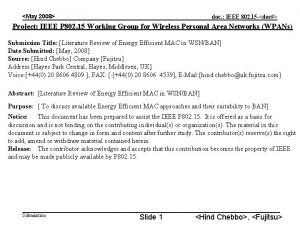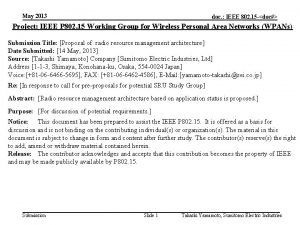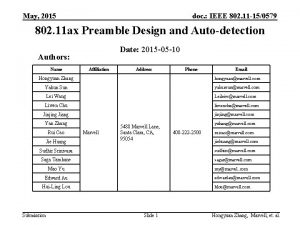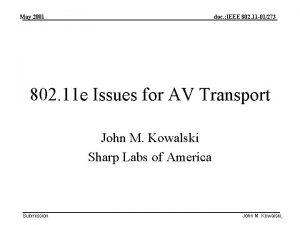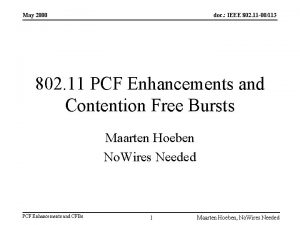May 2019 doc IEEE 802 11 190807 r













![May 2019 doc. : IEEE 802. 11 -19/0807 r 0 Reference [1] 19/0497 r May 2019 doc. : IEEE 802. 11 -19/0807 r 0 Reference [1] 19/0497 r](https://slidetodoc.com/presentation_image_h2/b08483fa01a93e6fcfac9cd4964449e9/image-14.jpg)
- Slides: 14

May 2019 doc. : IEEE 802. 11 -19/0807 r 0 Consideration on 20 MHz Channel Access in 11 bd Date: 2019 -05 -14 Authors: Submission Slide 1 Yongsu Gwak, Korea National University of Transportation

May 2019 doc. : IEEE 802. 11 -19/0807 r 0 Introduction • In 11 bd SFD [1], – In 20 MHz bandwidth, L-STF, L-LTF, and L-SIG for 10 MHz PPDU are duplicated as shown in the figure below • However, the baseline channel access procedure for wideband cannot be applied directly • Since there may not be concept of primary channel in OCB, careful consideration is needed to utilize 20 MHz • In this contribution, 20 MHz channel access procedures are discussed Submission Slide 2 Yongsu Gwak, Korea National University of Transportation

May 2019 doc. : IEEE 802. 11 -19/0807 r 0 Wide Bandwidth Channel Access • In the base specification in 11 n, wide bandwidth channel access using PIFS is specified Secondary 10 PIFS Primary 10 DIFS TXOP Wideband signal • In BSS, the primary channel is decided by AP – STAs in AP shares the same primary channel – The secondary channel usage is based on OBSS • Low probability for traffic on secondary channel as a primary channel Submission Slide 3 Yongsu Gwak, Korea National University of Transportation

May 2019 doc. : IEEE 802. 11 -19/0807 r 0 Considerations on 802. 11 bd Channels • Channel usage in NGV: no AP exists – OCB traffic – No primary channel • The channel used in 5. 9 GHz – Each channel has its own purpose – Each channel is equally important Ch 172 5. 855 GHz Ch 174 5. 865 GHz SCH safety Ch 176 5. 875 GHz Ch 178 5. 885 GHz SCH: may used in 20 MHz Ch 180 5. 895 GHz CCH Ch 182 5. 905 GHz Ch 184 5. 915 GHz SCH: may used in 20 MHz SCH safety • In order to access a 20 MHz channel in 802. 11 bd, contention channel shall be defined Submission Slide 4 5. 925 GHz Yongsu Gwak, Korea National University of Transportation

May 2019 doc. : IEEE 802. 11 -19/0807 r 0 Terminologies • In order to describe 20 MHz channel operation clearly, terminologies for different channel types need to be defined – Service channel, Contention channel, Extension channel • Contention channel – 10 MHz channel on which channel access procedure is performed – Similar to a primary channel in BSS • Service channel – 10 MHz channel on which a specific service, e. g. , BSM is delivered without 20 MHz wide channel operation • Extension channel – 10 MHz channel to which 20 MHz channel is extended Submission Slide 5 Yongsu Gwak, Korea National University of Transportation

May 2019 doc. : IEEE 802. 11 -19/0807 r 0 Option 1: Service Channel as Contention Channel • Current 10 MHz service channel is set as a contention channel – Example: Ch 174 & Ch 176 • For the applications use Ch 174, Ch 174 is set as a contention channel • For the applications use Ch 176, Ch 176 is set as a contention channel • Legacy wide channel access using PIFS can be reused – Channel contention is performed on the contention channel and the availability of the extension 10 MHz channel is checked during PIFS • Pros: Simple and reusing the existing procedure • Cons: Fairness problem on the extending 10 MHz channel Submission Slide 6 Yongsu Gwak, Korea National University of Transportation

May 2019 doc. : IEEE 802. 11 -19/0807 r 0 Option 1: Service Channel as Contention Channel (Cont’d) • 20 MHz PPDU Transmission Failure – Legacy Dynamic Bandwidth Operation • If the extension channel is busy during PIFS, the STA just transmits 10 MHz PPDU Submission Slide 7 Yongsu Gwak, Korea National University of Transportation

May 2019 doc. : IEEE 802. 11 -19/0807 r 0 Option 2: Dual Contention Channels • Both channels are contention channels • Both 10 MHz channels perform a channel access procedure independently – 20 MHz Channel can only be used upon successful backoff on the both channels • Pros: Highest fairness • Cons: Backward compatibility Postpone Access Ch 174 Ch 176 Submission Data Slide 8 10 MHz Yongsu Gwak, Korea National University of Transportation

May 2019 doc. : IEEE 802. 11 -19/0807 r 0 Option 2: Dual Contention Channels (Cont’d) • Various channel access failure cases can happen depending on the selected parameters (e. g. , backoff value) – Further rigorous investigation is required – Clear definition on the procedure shall be defined Submission Slide 9 Yongsu Gwak, Korea National University of Transportation

May 2019 doc. : IEEE 802. 11 -19/0807 r 0 Option 3: Dynamic Contention Channel for Channel Access • Set the contention channel between two 10 MHz channels at the time of channel access – Contention channel can be selected at random or alternatively or by using some additional information – Channel extension can be done when the extension channel is idle during TBD time • Pros: Fairness & Flexibility • Cons: Contention channel selection – Random selection – Additional information Submission Slide 10 Yongsu Gwak, Korea National University of Transportation

May 2019 doc. : IEEE 802. 11 -19/0807 r 0 Option 3: Dynamic Contention Channel for Channel Access (Cont’d) • 20 MHz PPDU Transmission Failure – If the contention channel is busy but the service channel is idle, the STA can transmit 10 MHz PPDU through the service channel Submission Slide 11 Yongsu Gwak, Korea National University of Transportation

May 2019 doc. : IEEE 802. 11 -19/0807 r 0 Conclusion • Option 1 is a legacy wide channel access procedure, and has an advantage of easy implementation. However, there is a fairness issue on the extension channel. • Option 2 is an independent backoff procedure, and guarantees the highest fairness among three options. However, it may have a backward compatibility problem. • Option 3 is a dynamic channel access procedure, and has fairness and flexibility. However, contention channel selection needs to be defined. Submission Slide 12 Yongsu Gwak, Korea National University of Transportation

May 2019 doc. : IEEE 802. 11 -19/0807 r 0 Straw Poll 1 • Which option do you prefer for 20 MHz channel access? – – Option 1: Service Channel as Contention Channel (11 n like access) Option 2: Dual Contention Channels Option 3: Dynamic Contention Channel for Channel Access None of above Submission Slide 13 Yongsu Gwak, Korea National University of Transportation
![May 2019 doc IEEE 802 11 190807 r 0 Reference 1 190497 r May 2019 doc. : IEEE 802. 11 -19/0807 r 0 Reference [1] 19/0497 r](https://slidetodoc.com/presentation_image_h2/b08483fa01a93e6fcfac9cd4964449e9/image-14.jpg)
May 2019 doc. : IEEE 802. 11 -19/0807 r 0 Reference [1] 19/0497 r 1 specification framework document Submission Slide 14 Yongsu Gwak, Korea National University of Transportation











